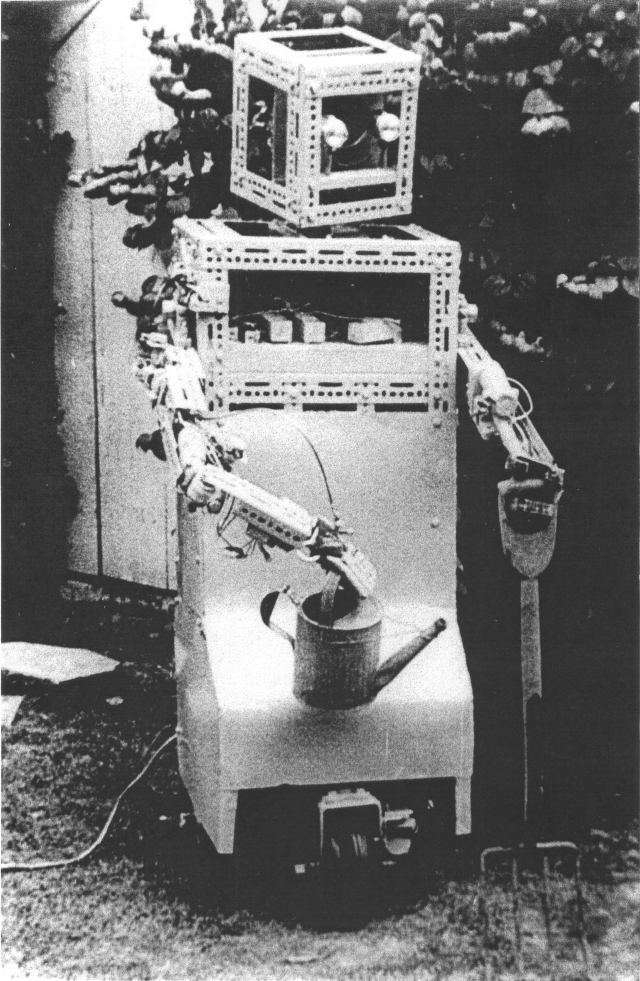
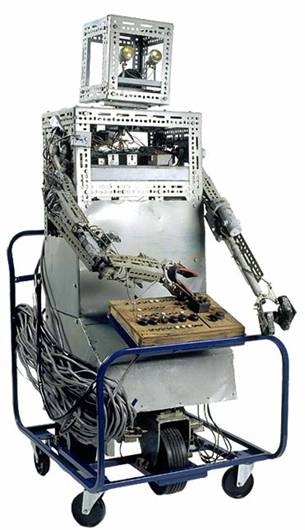
Above and below: "Robert" as he is today. These images are from the Scienceworks Science Museum's webpage (Photographed by Benjamin Healley). Reproduced courtesy of Museum Victoria. This pdf gives some information as well.
Robbie the Robot can currently be viewed as part of the Scienceworks collection store tour – just ask your tour guide to point him out. Tours run daily. Enquire at the Scienceworks information desk for details.
To limit wear and tear, Robbie, as the Museum calls him, now has the following maximum movement of parts – Right arm from just above the frame to a horizontal position.
The head revolves no further than to look over the left and right front corners of the main body.
The head tilts from looking straight ahead to looking down at approx. 20-25 degrees (to make eye contact with a child say 2 meters away.
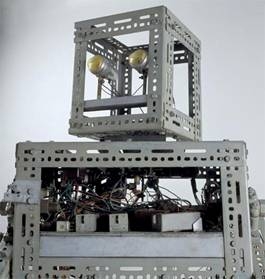
from a comment made on the Scienceworks site re Robbie
19/10/2009 09:03 PM
Daniel
Bernard Smith was my uncle and when we used to visit his house he would often fire up Robbie and make his arm go up and down, much to our excitement. He also built a painting machine which randomly selected colours and painted lines. He called one of these paintings "Primeval Forest II" and entered it into the Herald Sun Art Show. It didn't win any prizes but apparently someone purchased it.He also made a noughts and crosses machine using valve technology and programmed it by getting my father to play endless games of noughts and crosses whilst he recorded the results.
Here's the transcription of the film clip.
Fire the maid! -(if any)
Robert the Robot
LOVES Housework
Cinesound Review
Men, if you want a household help who wont lag, gossip, or rifle your wallet, why not let Robert the Robo(t) walk over your threshold. He does everything but talk. While a woman, huh! Invented by Bernard Smith of Campberwell, Melbourne he's 6 ft tall and pours the tea with the grace of a duchess. His weight, if you must know, is a quarter of a ton, and dieting wont help.
Inside he has 13 electric motors and 200 yards of wiring and he'll do your bidding if you press the right button in the remote-control. Bring the child in, show to Dadda, and then swing it to sleep. Certainly, Boss. Robert can go forward or backward, to the right or left or just stand still. He can lift a couple of hundred pounds, but never throws rolling pins or back answers.
Carpet's a bit dirty? Leave it to Robert. He's the perfect household help alright. Costs nothing for food, clothes or drink; always happy in his chores; leaves you in peace when you press the button. Yes, he's got everything, absolutely everything.
Robert, don't you dare wink you forward little robo(t) you.
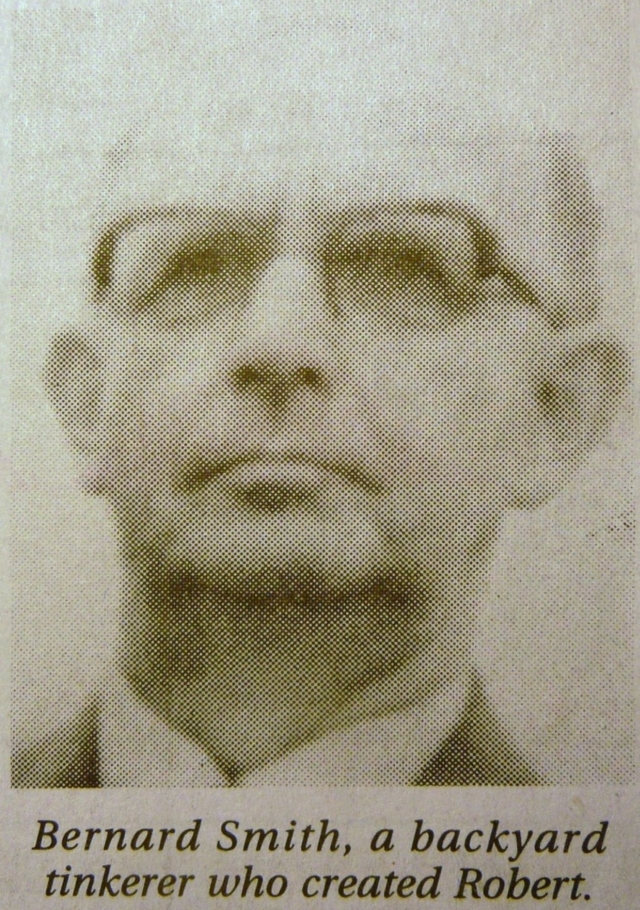
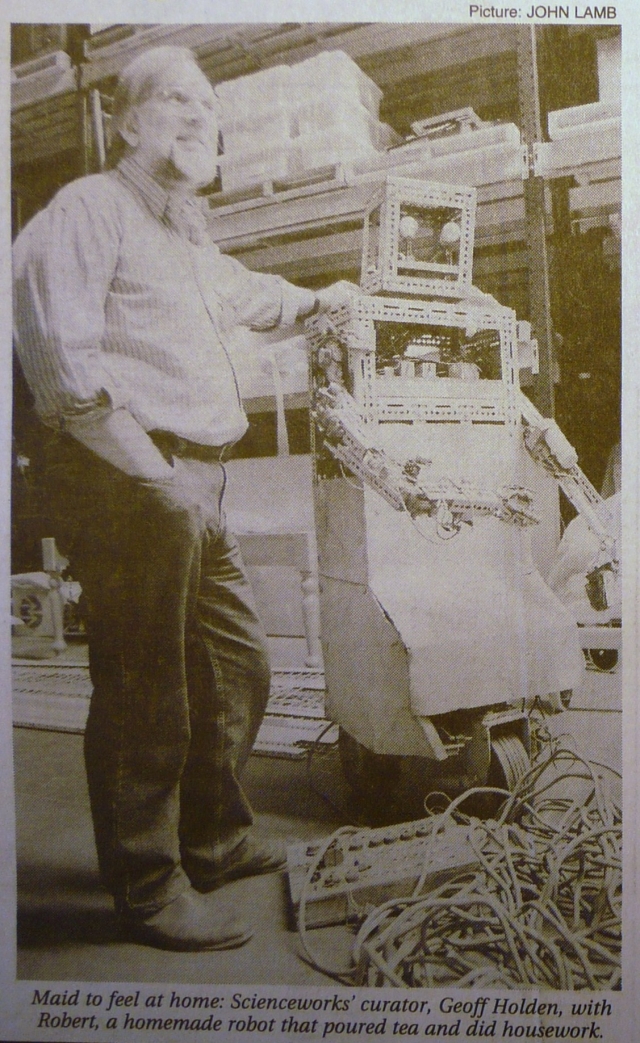
The past's vision of the future is today's museum piece
Author: JOHN LAHEY
Date: 01/02/1994
Publication: The Age Page: 2
Australians had a wonderful innocence in the 1950s. We believed in robots. The time was coming when robots would iron the clothes, rock the baby, clean the house and pour the tea. This belief was so strong that the robot pictured here actually starred in a newsreel called `Fire the Maid!'.
Robert the Robot (that's his name) has just gone to live at the Scienceworks museum in Spotswood. He is believed to be Australia's oldest surviving attempt at a robot. Certainly, he is the oldest in an Australian museum, says his curator, Geoff Holden.Before Scienceworks acquired Robert he was kept in a shed. His parts are wonky. Mr Holden says Robert will be slowly restored and perhaps he will be farded. I had to tell Mr Holden that I begged his pardon and would he mind repeating what he had just said please.
“Farded," said Mr Holden. “Do you know what farding is?" I said yes, but I didn't think it applied to robots. Crikey, you can learn a lot in museums. Well, it turned out that farding means to embellish or gloss over something, and as a specific term it means to put make-up on an old face. It means Robert might get a coat of paint.
He is a remarkable robot, made from bits and pieces by a clever school teacher called Bernard Smith, who lived in Camberwell and died last year, aged 68. Mr Holden said: “This was backyard tinkering, but Bernard Smith solved a lot of little technical problems along the way."
One of the great problems for modern inventors, apparently, is that all the old disposal shops, stocked with surplus goods from the Second World War, have gone out of business, and so nobody gets the chance to tinker and make things. Mr Smith built Robert during the heyday of disposal shops, using aeroplane parts, lengths of metal shelving, lumps of wood, bits of radios and all sorts of things.
Robert looked good in his Cinesound newsreel, dating from the early 1950s. He ran off two car batteries, either six-volt or 12-volt. As Robert went through the housework, a commentator said he stood six feet (about 183 centimetres), worked on 13 electrical motors and 200 yards of wiring, and had the grace of a duchess. This was in the days before programming. Robert functioned only when someone pressed buttons on a remote-control board.
You should have seen him in the movie delicately pouring the tea – a considerable feat, according to Mr Holden. “The hands of early robots just crashed the tea cups," he said. After Robert has been fixed and farded, Mr Holden thinks he might look good at the Scienceworks door, welcoming visitors and gesturing them inside.
Bernard Smith was an interesting inventor. He once devised a “painting machine", which drew random lines on paper, and he entered one of its productions in the Herald Outdoor Art Show under the title `Primeval Forest'. Someone bought it.

Bernard Smith studying up on Robots
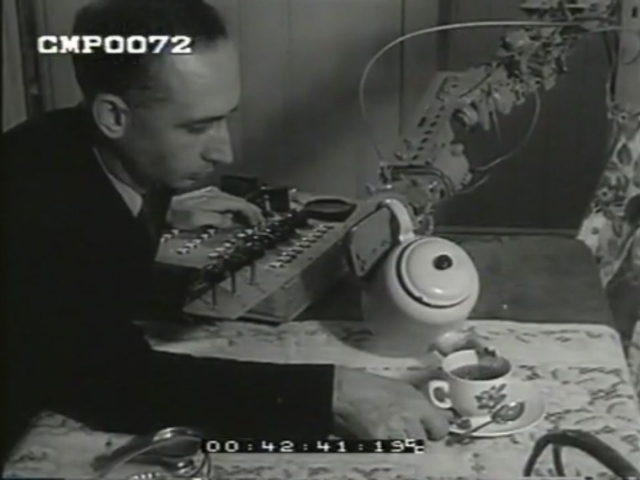
Dexterity being shown by pouring a cup of tea. Note the 3 potentiometers mounted on the outboard panel. These gave positional control of the right-arm, as distinct from the push-button start-stop controls.
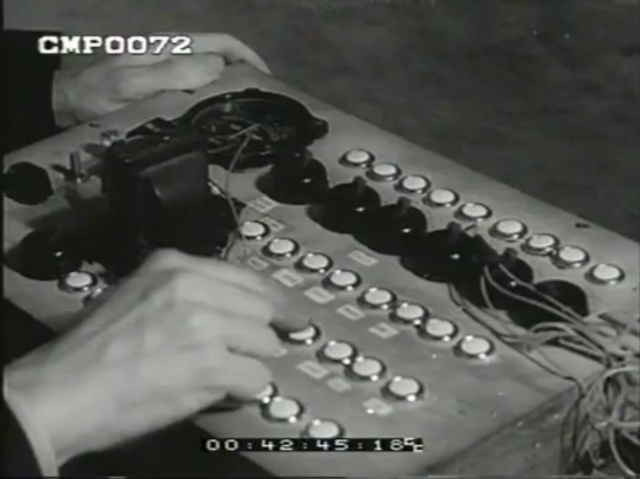
A close-up of the earlier remote control panel
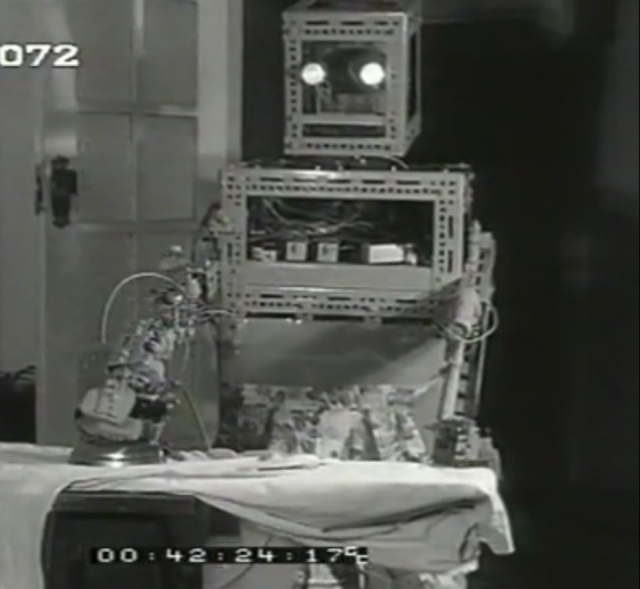
Robbie tirelessly does the ironing…
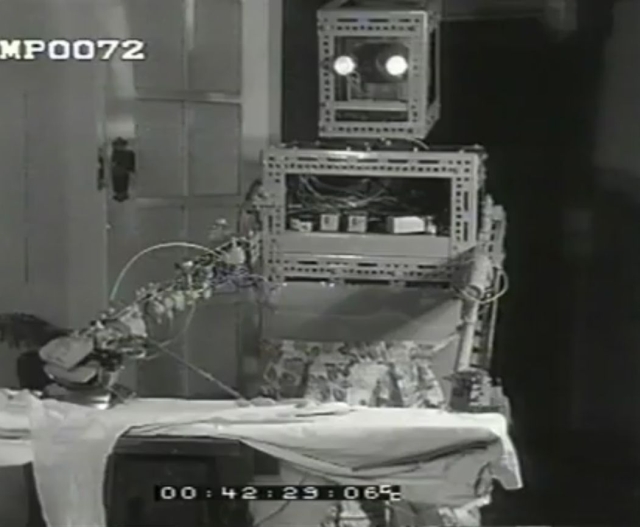
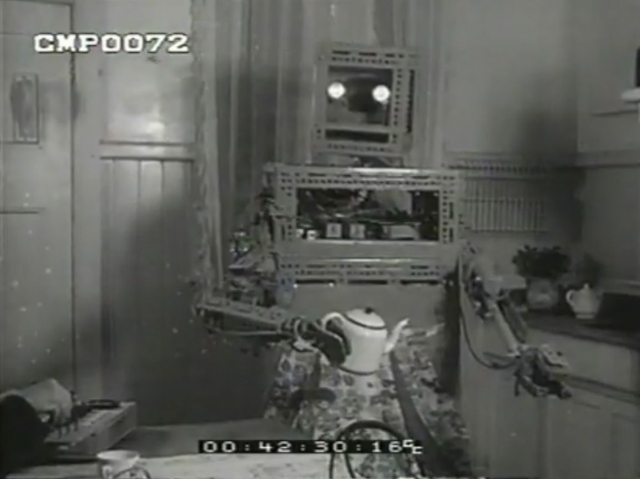
and collects the tea pot …
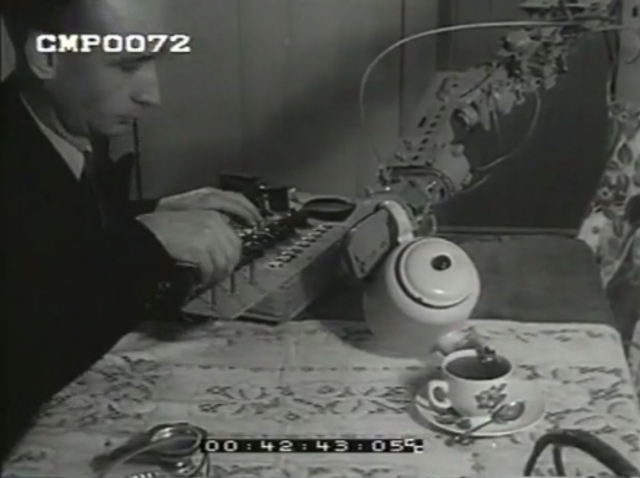
then pours a cuppa for his master….

With powerful motors, and a heavy body, Robert was capable of holding a small child whilst traversing across the floor without tipping over.
Built in the early 1950's by Bernard Smith a school teacher who lived in Camberwell, Victoria, Australia and at one time taught science at Hyde St. school in Footscray.
Robbie is built from military disposal parts of which there was a plentiful supply after WW2.
He originally ran off 2 x 12 volt car batteries but for convenience he isnow run from a 240/24v power supply.
The wheels are tail wheels from Mustang fighter aeroplanes.
The 24v motors (13 of them – see description below) would have served various duties in aeroplanes such as operating flaps, bomb bay doors etc.
Although the Motors are fairly small they exert tremendous force due to their gearing (several thousand to one).
As well as the above there are:
36 Relays
16 Capacitors
9 Potentiometers
16 Resistors
1 Transformer
32 Pushbuttons 7 Switches
Approx. 150 meters of multi-core cable
No.1 TURNS HEAD
No.2 NODS HEAD
No.3 OPENS/CLOSES LEFT HAND
No.4 EXTENDS LEFT ARM
No.5 RAISES/LOWERS LEFT ARM
No.6 OPENS/CLOSES RIGHT HAND
No.7 REVOLVES RIGHT HAND
No.8 OPERATES RIGHT LOWER ELBOW
No.9 OPERATES RIGHT UPPER ELBOW
No.10 RAISES/LOWERS RIGHT ARM
No.11 PROPULSION MOTOR
No.12 STEERING MOTOR (MISSING)
No.13 DYNAMOTOR INPUT 28V DC OUTPUT 250V DC
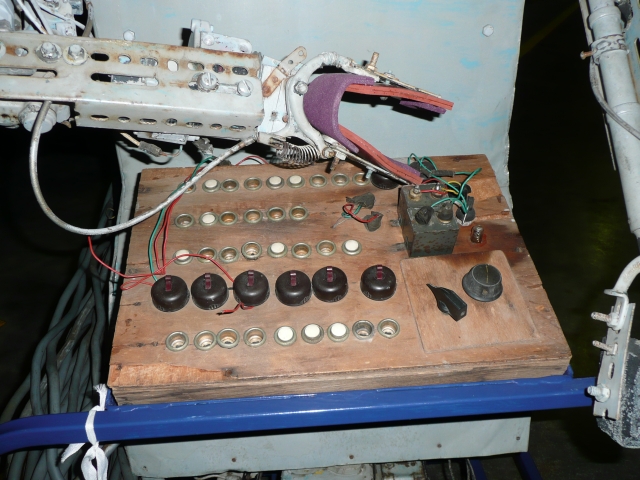
Right forearm, wrist, gripper, and original control panel. Reproduced courtesy of Museum Victoria.

Reproduced courtesy of Museum Victoria.
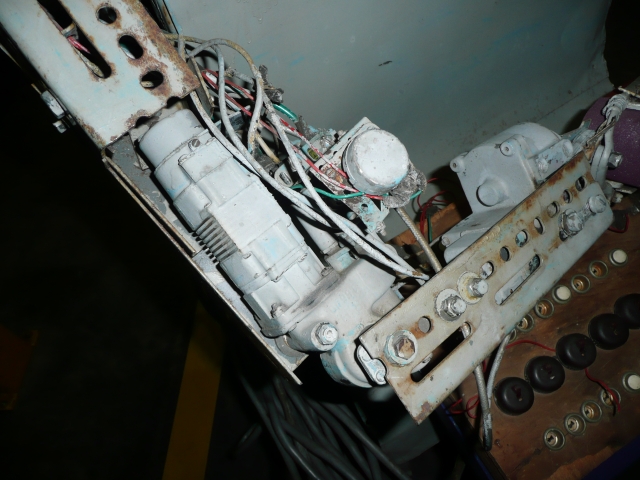
Detail of right-elbow showing the positioning potentiometer. Reproduced courtesy of Museum Victoria.

Detail of right-arm. Reproduced courtesy of Museum Victoria.

publication unknown – 1 May 1956
Robots by Robert the Robot
The author has constructed a robot named Robert, and intended as a step towards the useful household servant ideal. Robert, 6 ft. tall, is broarder and thicker than any man. Made of steel, he weighs nearly a quarter of a ton. He is controlled remotely through 150 ft. of cable. Like the Robot, Garco, his right arm is controlled by a miniature arm. This can be moved by a flick of the little finger, but the robot's corresponding action is at least as powerful as that of any human arm. The left arm moves up and down and is push-button controlled. Left and right arms both have a gripping and releasing action and can spin clockwise and anti-clockwise. Other buttons move Robert forward and backward, turn him right and left.
Many people in our community with minds perfectly sound have bodies which ideally limit their activities. We can imagine such a person able to move only a few fingers of one hand. He could easily and safely control a Mark 3 Robert. Robert could nurse him, move him from place to place, and even help him do carpentry and gardening.
Boxing is a sport under fire at the moment. Why not replace the boxers with robots, regulating h. p., weight, armour. etc. Fights could then be to the death. As a "logIcal" development of Australian Rules [RH-2010 -Australia's football code], why not robot footballers? These could be repaired much more quickly than live ones. The stars of yesterday could control the robots from the sideline and the umpire, remotely checking the game a hundred miles away, would be compartitively safe.
Before you laugh off robots remember that many people laughed even more heartily at the first car. Obedient mechanical servants would be most useful, and while Robert has his faults, he is wide open to improvement.
It is interesting to recall that W. Grey Walter, in designing and constructing his robot tortoises, did so with the concept of "parsimony". That is, the adoption of the simplest and most frugel way to achieve the desired outcome. In Walter's case, for example, the valves [vacuum tubes] were connectd normally as amplifiers, then switched to be a multivibrator when triggered by the contact sensor. Without parsimony being applied, we might have seen an additional second set of valves wired for a single purpose,
What we see in Robert, which is more frugal than in "Garco" (see here), is based on the observation that as most people are right-handed, it is important for the right arm and hand to be the more dexterous given that the other arm, the left in most cases, is used far less and for much simpler tasks. [Note- RH -The equation is a little different for left-handed people like myself who are more capable with their non-preferred arm/hand given that the world's artifacts are largely built by and for right-handed people!]
In Garco's case, the left claw is shaped differently than the right, and is designed more for holding things, whereas the right hand is smaller and pincer shaped offering more complex movement and finer control. Also like Garco, the remote control arm is for the right hand/arm, whereas the left is only push-button controlled. Although the above text on Robert mentions a miniature arm on the control panel, although modifications have been made over time, I cannot see it in either of the still shots or in the video clip, although there is an out-board panel in the video that has three potentiometers and as seen in the video clip that does control the positioning of the arm and hand. The potentiometers in both the control panel and the arm work together to form a Wheatstone bridge. When the control panel potentiometer moves, the robot's arm servo's in to equalise the bridge, thus reflecting the same positional change. The use of remote control arms is now current practice in the form of "Waldo's" as used in animatronics and animation, although they are digitally controlled. As I mentioned on the Garco page, the control arm of the master-slave unit pre-dates the harness used by the Disney Imagineers for their Audio-Animatronics by 10 years. Robbie is the second Humanoid robot that I'm aware of that employed this remote-controlled servo feedback positioning technology.
Robert's left arm is capable of being raised up or down, extends the length of the forearm, and open or close his left hand. He has no elbow, and cannot rotate his wrist.
His right arm, although it cannot extend, has a bendable elbow and a rotatable wrist.
Some other aspects in the above article worth mentioning is Smith's prediction in what we now call "Robot Wars", i.e. robots that 'fight to the death', and more interesting, as well as the use for hazardous materials, the use as a household servant to assist those with less-abled bodies, doing chores such as carpentry and gardening. Very few before Bernard Smith have reflected on this aspect, prefering to focus on a future society where robots are labour saving devices to give us humans more leisure time.
What was lacking in Smith's time were small, programmable control devices. We really had to wait another 30 years or so on the microprocessor with sufficient processing speed and memory to control the hardware.
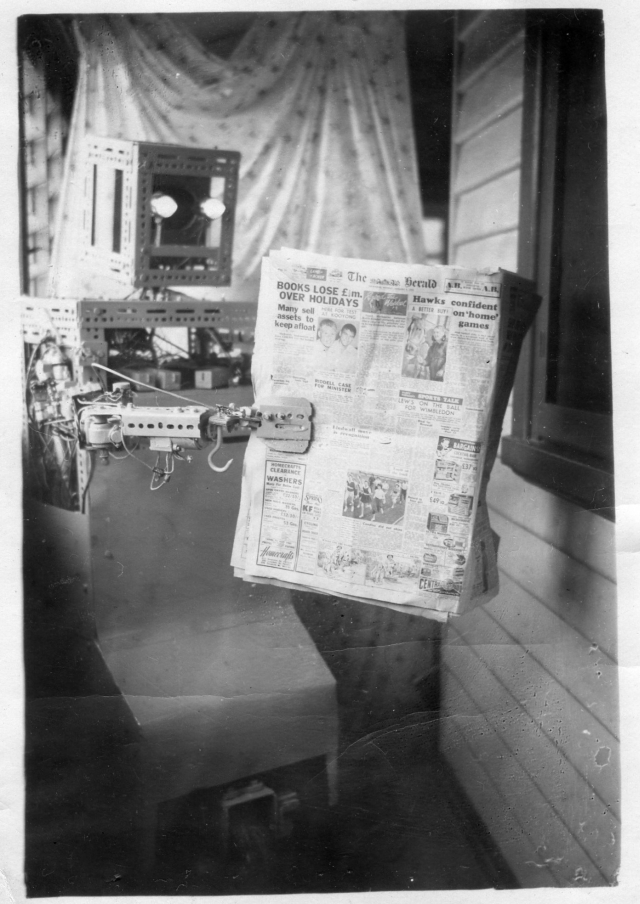
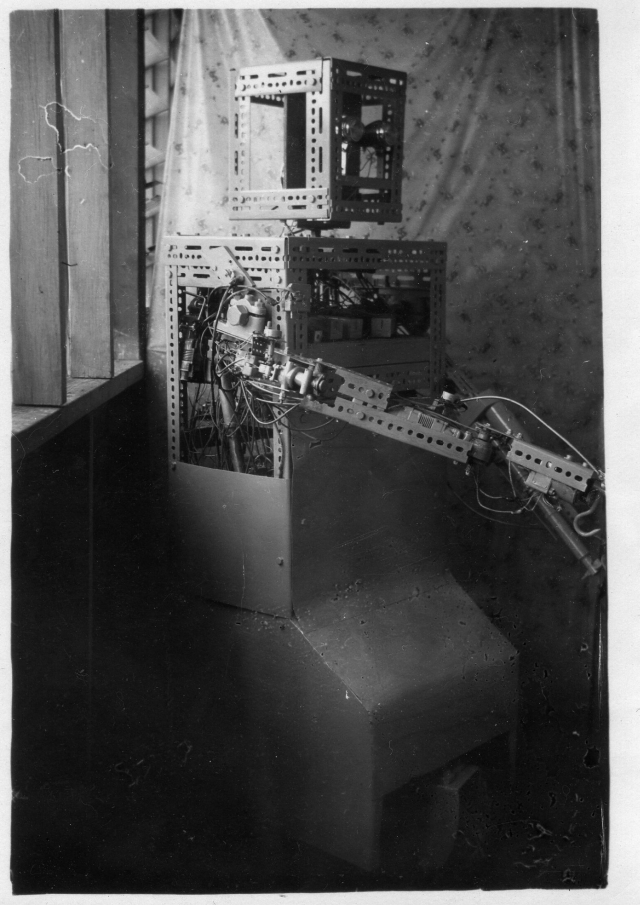

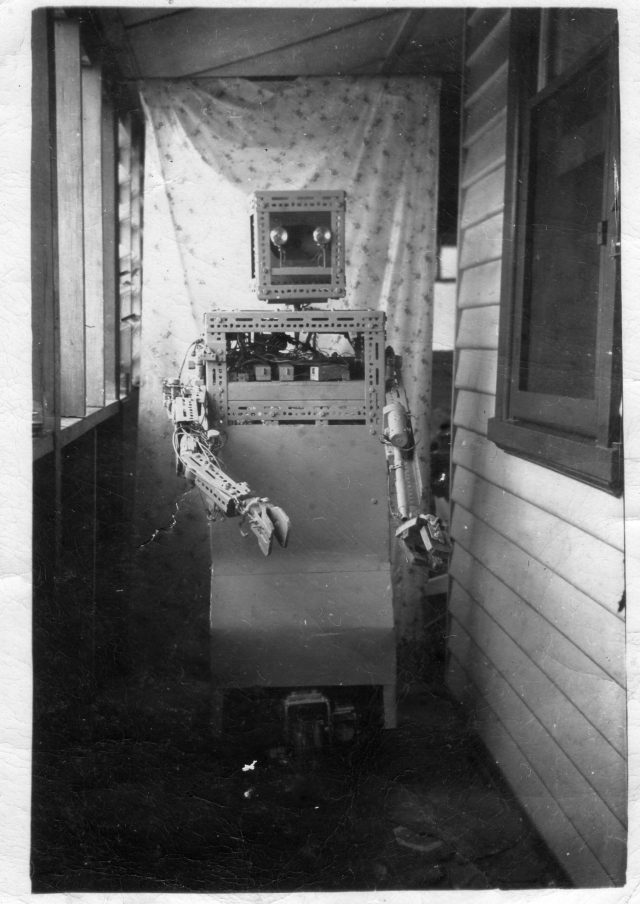
The above photos were taken by Bernard's late brother, Paul Smith. Thanks to Paul's son Daniel for supplying the images.
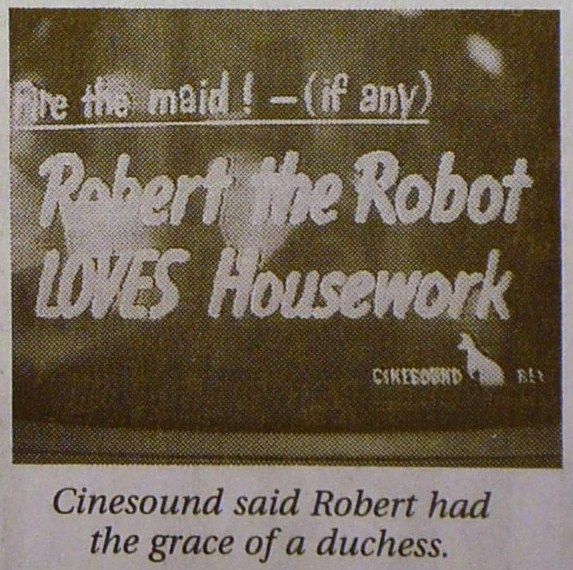
I was able to see Robot one day at Scienceworks and the man who took us around got a shock when myself and my family said that our Great Uncle made Robert the Robot but it was a fascinating experience. It was great to see a second cousin who isn’t a human.
from Youtube video clip –
My uncle built Robbie to demonstrate the possibilities of robotics. He also worked for many years on Robbie Mark II but didn’t finish him. As kids we liked to terrify ourselves by peering into the garden shed where Robbie was kept and imagine he was coming after us. My uncles house always had a slightly disconcerting collection of inventions in various stages of completeness but he had a great train layout (Hornby O Gauge) in one room which he was always also working on but never finished
As Bernard Smiths Great-Nephew I am very proud to see this website put up for my Great-Uncle’s invention. I have heard so many stories about him and old photo’s. I haven’t seen him yet but I would love to.
I love this, Reuben! This is hobby robot hacking at its finest, especially for the era. Gosh, I wish I could have known Bernard and his robot back in the day…